Competitive Analysis for Product Launch: 5 Strategic Frameworks
Did you know that 75% of product launches fail to meet their market expectations within the first year? Behind every unsuccessful launch lies a critical missed opportunity: comprehensive competitive analysis.
Marketing and product strategy professionals understand the high-stakes challenge of introducing a new technology solution. With limited resources and immense pressure to deliver breakthrough products, teams often rush forward without truly understanding the competitive landscape—a decision that can derail months of development and significant financial investment.
Strategic competitive analysis isn't just about tracking competitors; it's about systematically validating product-market fit, identifying unmet customer needs, and creating a differentiation strategy that resonates with your target audience. In this exploration, we'll unpack five rigorous frameworks that transform competitive insights from abstract data points into actionable market positioning strategies.
Understanding Competitive Analysis for Product Launches
Competitive analysis is a systematic process of identifying, evaluating, and documenting the strengths, weaknesses, strategies, and capabilities of current and potential competitors in your market ecosystem. At its core, it's a strategic intelligence gathering mechanism that provides critical insights into how your product can effectively differentiate and succeed.
For B2B technology professionals, competitive analysis transcends mere competitor tracking. It's a strategic tool that delivers multifaceted benefits:
- Market Positioning: Uncover precise white spaces where your product can uniquely solve customer challenges
- Risk Mitigation: Anticipate potential market barriers and competitive responses before investing significant resources
- Strategic Planning: Develop data-driven product roadmaps aligned with emerging market dynamics
- Customer Insight Generation: Understand unmet customer needs through comprehensive competitive landscape analysis
Effective competitive analysis transforms raw market data into a strategic navigation system. It enables product and marketing teams to move beyond reactive responses, proactively crafting solutions that resonate with target customers' evolving requirements.
The most successful competitive analyses blend quantitative market research with qualitative strategic insights, creating a holistic understanding of the competitive terrain.
Why Competitive Analysis Matters for Your Business
For B2B technology companies and SMBs, competitive analysis isn't a luxury—it's a strategic imperative. The market doesn't reward wishful thinking; it rewards deep, nuanced understanding of customer needs and competitive dynamics.
Key Business Benefits
- Enhanced Market Penetration By identifying unoccupied market segments and customer pain points, businesses can develop targeted solutions that cut through competitive noise and directly address specific market needs.
- Improved Product-Market Fit Rigorous competitive analysis helps validate product concepts before significant investment, reducing the risk of developing solutions that miss critical market requirements.
- Strategic Resource Allocation Understanding competitive landscapes allows leadership to prioritize development efforts, focusing resources on features and innovations that genuinely differentiate the product.
- Predictive Market Intelligence Advanced competitive analysis provides early warning signals about emerging technologies, shifting customer preferences, and potential disruptive market changes.
Common Competitive Analysis Pitfalls
Despite its importance, many businesses stumble in their approach:
- Relying solely on surface-level competitor information
- Neglecting qualitative customer insights
- Treating competitive analysis as a one-time exercise instead of an ongoing process
- Failing to translate competitive insights into actionable strategies
The most successful organizations view competitive analysis as a dynamic, continuous dialogue with the market—not a static report gathering dust on a shelf.
5 Strategic Frameworks for Comprehensive Competitive Analysis

Transforming competitive intelligence into a powerful product launch strategy requires a systematic, multidimensional approach. These five frameworks will equip you with the tools to conduct a rigorous and actionable competitive analysis.
1. Market Landscape Mapping
Create a comprehensive visualization of your competitive ecosystem.
- Action Steps:
- Identify direct and indirect competitors
- Categorize competitors by market segment and offering
- Create a visual competitive landscape matrix
- Pro Tips:
- Use tools like Gartner Magic Quadrant or competitive positioning maps
- Include emerging startups and potential disruptors
- Mistakes to Avoid:
- Overlooking niche or adjacent market players
- Focusing only on current competitors, not potential future entrants
2. Detailed Competitor Profiling
Develop a deep understanding of each competitor's strategic positioning and capabilities.
- Action Steps:
- Analyze competitor product features and pricing
- Review marketing messaging and positioning
- Examine customer reviews and market feedback
- Pro Tips:
- Use tools like G2, Capterra, and industry-specific review platforms
- Track competitors' social media and content marketing strategies
- Mistakes to Avoid:
- Relying on outdated or superficial information
- Neglecting qualitative customer sentiment analysis
3. Unmet Customer Need Identification
Uncover market gaps and potential differentiation opportunities.
- Action Steps:
- Conduct customer interviews and surveys
- Analyze support tickets and customer feedback
- Identify recurring pain points not addressed by current solutions
- Pro Tips:
- Use Jobs-to-be-Done (JTBD) framework for deeper insights
- Create customer persona maps to understand specific needs
- Mistakes to Avoid:
- Assuming you know customer needs without direct research
- Overlooking diverse customer segments
4. Technology and Innovation Tracking
Stay ahead of technological shifts and emerging market trends.
- Action Steps:
- Monitor patent filings and research publications
- Track venture capital investments in your domain
- Attend industry conferences and webinars
- Pro Tips:
- Use platforms like Crunchbase and CB Insights
- Set up Google Alerts for key technology trends
- Mistakes to Avoid:
- Ignoring emerging technologies and startups
- Becoming complacent about technological disruption
5. Continuous Competitive Intelligence Framework
Establish an ongoing competitive monitoring system.
- Action Steps:
- Create a quarterly competitive review process
- Develop a standardized competitive intelligence template
- Integrate insights across product, marketing, and strategy teams
- Pro Tips:
- Use collaborative tools for real-time insight sharing
- Develop a cross-functional competitive intelligence team
- Mistakes to Avoid:
- Treating competitive analysis as a one-time event
- Siloing competitive insights within single departments
Essential Tools and Frameworks for Competitive Intelligence

Executing a robust competitive analysis requires more than strategic frameworks—it demands the right technological arsenal and proven methodologies to transform insights into actionable intelligence.
Recommended Tools
-
SEMrush
A comprehensive digital marketing intelligence platform enabling competitive keyword research, website traffic analysis, and comprehensive market positioning tracking. Ideal for understanding online competitive landscapes.
-
Crayon
An AI-powered competitive intelligence software that automatically tracks competitors' digital footprints, providing real-time insights across websites, social media, job postings, and marketing campaigns.
-
SimilarWeb
Digital market intelligence tool offering deep website traffic analytics, audience demographics, and comparative performance metrics across digital channels.
-
Kompyte
Automated competitive tracking platform that monitors competitors' digital strategies, pricing changes, and market positioning in near real-time.
-
Klue
Competitive enablement platform integrating AI-driven intelligence gathering with collaborative insights sharing across organizational teams.
Strategic Frameworks
-
Porter's Five Forces
Provides a holistic analysis of competitive dynamics by examining industry competition, potential market entrants, supplier power, customer power, and substitute product threats.
-
Blue Ocean Strategy
Focuses on creating uncontested market spaces by developing differentiated value propositions that render competition irrelevant.
-
SWOT Analysis
Classic framework for evaluating Strengths, Weaknesses, Opportunities, and Threats within your competitive ecosystem.
-
Jobs-to-be-Done (JTBD)
Customer-centric framework that explores product positioning by understanding the fundamental problems customers seek to solve.
-
Benchmarking Framework
Systematic approach for comparing performance metrics, strategies, and capabilities against industry leaders and direct competitors.
By integrating these tools and frameworks, B2B technology professionals can develop a nuanced, data-driven approach to competitive intelligence that goes beyond surface-level observations.
Conclusion: Integrating Competitive Analysis into Your Product Launch Strategy
Mastering competitive analysis is not just about collecting data, but transforming insights into strategic advantages that differentiate your product in the market. By systematically mapping competitor landscapes, understanding nuanced market dynamics, and leveraging sophisticated analytical frameworks, marketing and product strategy professionals can significantly reduce launch risks and optimize positioning. The most successful product launches emerge from a holistic approach that combines rigorous competitive intelligence, deep customer understanding, and adaptive strategic planning. Remember that competitive analysis is an ongoing process—continuous monitoring, iterative refinement, and proactive adaptation are key to maintaining a competitive edge in the rapidly evolving B2B technology ecosystem. Your ability to synthesize complex market signals and translate them into actionable product strategies will ultimately determine your launch's success and long-term market relevance.
